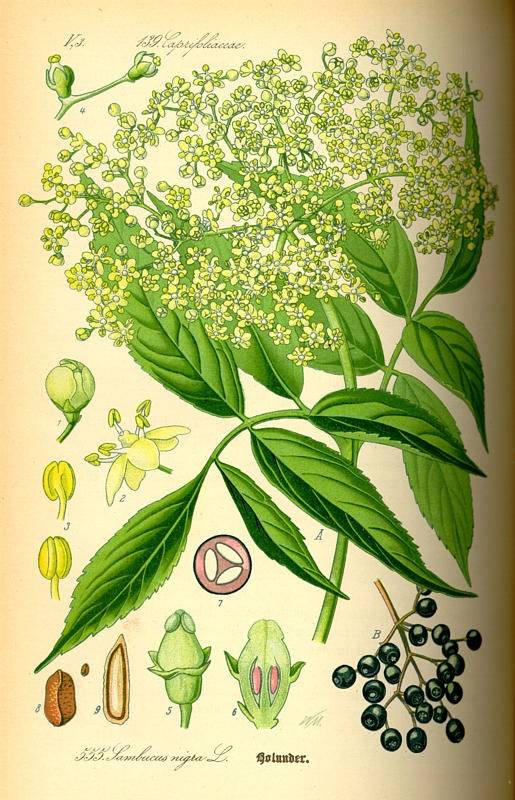
Black elderberry – Sambucus nigra
Description of black elderberry:
Sambucus nigra U. (Old or other familiar names: elderberry, elder tree, elder bush, elder bush, bocfa, wood elder, wood elder, lawn elder, lawn elder, lawn elder, bojza, borzék, csete) Groundsel – Caprifoliaceae Black elderberry, tree- or shrub-shaped; rarely grows more than 6 m tall, up to 9.5 m. The bark of its trunk is raggedly cracked and peeled off by greyish-brown scales. Its wood has a large, soft white gut and is easily picked out from the dead branches. The branches are translucent, at first when young; weakly four-edged and greenish, later becoming rounded and covered with a greyish cushion of bark. Branches transverse, oddly winged, i.e. consisting of 4-6 evenly opposite and one odd terminal leaflet. The individual leaflets are short-tongued, elongated elliptic, pointed-tipped and with serrate margins. The leaves are dark green above and lighter green behind. Elder leaves and green stems have a peculiarly unpleasant, strong smell and pungent bitter taste, are white, and form large, very small, large, 10-15 cm diameter, tent-like inflorescences. The inflorescence consists of a shorter central main branch and 4 longer, more branched lateral branches. All the flowers are approximately in a horizontal plane. Individual flowers are small only 4-5 mm in diameter; yellowish-white,with a strong conquering odour. The flower produces a black berry which is round, fleshy and has a nice red juice. The berry usually hides 3 hard-walled seeds. Elderberries flower in June and their berries begin to ripen in August.
Occurrence:
Black elderberry is found throughout our country in scrub and thickets, mostly in the interior of villages. It is a well-known shrub in Central Europe and Central Asia.
Central and Central European countries:
The flowers of black elder are used as a sweetening tea and sold as flores sanmbuci; its fresh berries are used to brew a flavour(roob sambuci or succus sambuci inspissatus), which is a laxative medicinal jam. The dried berries are also sold under the name fructus sambuci or grana actes. Both the elderflower and the berries are much sought after. The leaves of the elder tree are also used as a sweating tea, and elderberry root tea is used against dropsy. Elder bark used to be used in medicine, but no longer. Elderflower has a strong, characteristic odour, contains little volatile oil, tannins and resins. Black elderflower tea has a strong diaphoretic and diuretic effect without being irritating; it is also a blood purifier and is therefore drunk as a spring cure. Elderberry water also has a diaphoretic and sudorific effect. It is used to dye red wine. Elderflower is an important plant in both general and folk medicine. It is also used on its own to make tea and is an ingredient in many kinds of tea. The berries can be made into a medicinal wine with a sudorific effect. It is also used as a bath, rinse and mouthwash. It has also been used as a dyeing plant for industrial purposes. Its bark has also been used as a wormicide in folk medicine.
Active ingredient:
The flowers contain volatile oil, resin, vitamins, potassium salts, saponin, flavonoids (2-3% rutin, quercetin, sambucin) saponins (ursolic acid)chlorogenic acid, 0.1-0.2% cyanoglycosides (sambunigrin), and a meconium substance. The fruit contains organic acids, malic acid, acetic acid, fatty acids, anthocyanins (sambucyanins), folic acid, vitamin A provitamin, vitamins B and C, iron, wax, gum, glucose, tannic acid, bitter substances and resins. Tannins, sambunigringlycoside may accumulate in the leaf.
Cultivation:
In view of the high demand for black elderberries, it is worth cultivating. It is not particular about soil (except in saline, stagnant wetlands). It prefers nitrogen-rich areas with good water management. Can be propagated by sowing seeds and woody cuttings in early spring. Plants should be planted at least 1 m apart, in larger areas it is advisable to keep the row spacing of the plants at 5-6 m and the staking spacing at 3-3.5 m. Its cultivation has a longer tradition in the USA. It has relatively few pests/pathogens, but black aphids may occur.
Harvesting:
Elderflower should be harvested at the beginning of the flowering season, when the flowers have not yet fallen; in our area this is usually late May to early June. The large, tent-like inflorescence is cut off the stalk and dried. When drying, care must be taken to retain the colour as much as possible, as a browned elderflower is worthless. If the elderflower is picked when wet, it is easily blackened. For this reason, elderflowers should only be picked in dry weather, after the dew has settled. The picked flowers should be dried quickly in the sun on a tarpaulin. To ensure that the flowers dry quickly, spread them out thinly and roll them around tightly. (They dry in 1-2 days in hot sun) Cut off the thick stems after picking, because they contain a lot of water, slow down the drying of the flowers and spoil the flower stock. Elderflowers can also be dried in an airy attic, but it is best to hang the flowers on spars. In a heated room in rainy weather, dry the flowers on a tarpaulin or string. 6 kg of fresh flowers will make 1 kg of dry flowers. The dried flowers are later cleaned of their stalks and rubbed through a separate sieve, whereby the small flowers are separated from their stems and pass through the sieve. The flowers are not interchangeable with those of the elderberry(Sambucus ebulus), which is worthless, and differ from them mainly in that the inflorescence of the black elderberry has 5 main branches, whereas the elderberry has only 3. Black elderberries are picked when ripe, in September-October, with the stalk removed after drying. Eating raw or unripe elderberries can cause nausea and vomiting! However, the compounds that cause these symptoms are broken down by heat! Source: Dr. Ferenc Darvas and Dr Gyula Magyary-Kossa,Domestic herbs, their production, marketing, effects and medicinal uses Béla Páter, Wild medicinal plants, their production, use, distribution, and marketing Bertalan Galambosi, 88 colour pages on spices and medicinal plants Reader’s Digest, Nature’s herb garden Kolos-Pethes, Our native herbs
